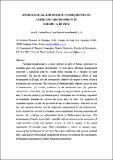Por favor, use este identificador para citar o enlazar a este item:
http://hdl.handle.net/10261/38123COMPARTIR / EXPORTAR:
 SHARE SHARE
 CORE
BASE CORE
BASE
|
|
| Visualizar otros formatos: MARC | Dublin Core | RDF | ORE | MODS | METS | DIDL | DATACITE | |

| Título: | Hydrological and erosive consequences of farmland abandonment in Europe, with special reference to the Mediterranean region – A review |
Autor: | García-Ruiz, José María CSIC ORCID ; Lana-Renault, Noemí CSIC ORCID | Palabras clave: | Farmland abandonment Runoff generation Soil erosion Bench terrace fields Semiarid areas Europe |
Fecha de publicación: | mar-2011 | Editor: | Elsevier | Citación: | Agriculture Ecosystems and Environment 140(3-4): 317-338 (2011) | Resumen: | Farmland abandonment is a major problem in parts of Europe, particularly in mountain areas and semiarid environments. In such places, farmland abandonment represents a significant land use change from cropping to a complex of plant successions. The present study assesses the hydromorphological effects of land abandonment in Europe, and the consequences thereof with respect to water resource availability and soil erosion. The evolution of abandoned fields depends on (i) the time of abandonment; (ii) climatic conditions in the abandoned area; (iii) particular characteristics of the fields; (iv) the land management regimen following abandonment; and, (v) the role played by government policy. Throughout most of Europe, vegetation on abandoned farmland has evolved into dense forest or shrub. The expansion of vegetation explains, in part, the perceived decline in water resources, reductions in soil loss and sediment delivery, and the progressive improvement of soil characteristics. Such evolution has resulted in changing stream morphology, featuring narrowing and incision, and a decline in sedimentation level in Mediterranean reservoirs. The abandonment of bench terrace fields coincided with an increase in the occurrence of small landslides in the steps between terraces, as well as changes in the spatial organization of saturated areas. Plant colonization is slower in semiarid areas, increasing the development of soil crusts that reduce infiltration and increase overland flow. Land policies with detailed capability are necessary to remediate the consequences of farmland abandonment in various European environments. | Descripción: | 22 páginas, 11 figuras, 3 tablas.-- El PDF del artículo es la versión manbscrita del autor. | Versión del editor: | http://dx.doi.org/10.1016/j.agee.2011.01.003 | URI: | http://hdl.handle.net/10261/38123 | DOI: | 10.1016/j.agee.2011.01.003 | ISSN: | 0167-8809 |
| Aparece en las colecciones: | (IPE) Artículos |
Ficheros en este ítem:
| Fichero | Descripción | Tamaño | Formato | |
|---|---|---|---|---|
| Páginas de AGEE-S-10-01118.pdf | 867,95 kB | Adobe PDF |  Visualizar/Abrir |
CORE Recommender
SCOPUSTM
Citations
360
checked on 22-abr-2024
WEB OF SCIENCETM
Citations
327
checked on 26-feb-2024
Page view(s)
404
checked on 24-abr-2024
Download(s)
1.065
checked on 24-abr-2024
Google ScholarTM
Check
Altmetric
Altmetric
NOTA: Los ítems de Digital.CSIC están protegidos por copyright, con todos los derechos reservados, a menos que se indique lo contrario.
